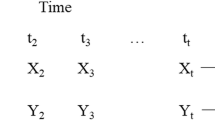Abstract
A central theme of research on human development and psychopathology is whether a therapeutic intervention or a turning-point event, such as a family break-up, alters the trajectory of the behavior under study. This paper lays out and applies a method for using observational longitudinal data to make more confident causal inferences about the impact of such events on developmental trajectories. The method draws upon two distinct lines of research: work on the use of finite mixture modeling to analyze developmental trajectories and work on propensity scores. The essence of the method is to use the posterior probabilities of trajectory group membership from a finite mixture modeling framework, to create balance on lagged outcomes and other covariates established prior to t for the purpose of inferring the impact of first-time treatment at t on the outcome of interest. The approach is demonstrated with an analysis of the impact of gang membership on violent delinquency based on data from a large longitudinal study conducted in Montreal.
Similar content being viewed by others
References
Cloward R.A., Ohlin L.E. (1960) Delinquency and Opportunity: A Theory of Delinquent Gangs. Free Press, New York
Cohen A.K. (1955) Delinquent Boys: The Culture of the Gang. Free Press, Glencoe, IL
Drake C. (1993) Effects of misspecification of the propensity score on estimators of treatment effect. Biometrics 49:1231–1236
Elder G.H. Jr. (1985) Perspectives on the life course. In: Elder G.H. Jr. (ed) Life Course Dynamics. Cornell University Press, Ithaca, NY
Elder G.H. Jr. (1998) The life course as developmental theory. Child Development 69:1–12
Farrington D.P. (1986) Age and crime. In: Tonry M., Morris N. (eds) Crime and Justice: An Annual Review of Research, Vol. 7. University of Chicago Press, Chicago
Haviland A., Nagin D.S., Rosenbaum P.R. (2005) Combining group-based trajectory analysis, propensity scores, and matching for causal analysis of the effect of gang membership on violence. Manuscript under preparation
Imbens G. (2004) Nonparametric estimation of average treatment effects under exogeneity: A review. Review of Economics and Statistics 86:4–29
Jones B.L., Nagin D., Roeder K. (2001) An SAS procedure based on mixture models for estimating developmental trajectories. Sociological Research and Methods 29:374–393
Korn E.L., Graubard B. (1999) Analysis of Health Surveys. Series in Probability and Statistics. Wiley, New York
Lacourse E., Nagin D., Vitaro F., Claes M., Tremblay R.E. (2003) Developmental trajectories of boys delinquent group membership and facilitation of violent behaviors during adolescence. Development and Psychopathology 15:183–197
Leon A.C., Hedeker D. (2005) A mixed-effects quintile-stratified propensity adjustment for effectiveness analyses of ordered categorical doses. Statistics in Medicine 24:647–658
Leon A.C., Mueller T.I., Solomon D.A., Keller M.B. (2001) A dynamic adaptation of the propensity score adjustment for effectiveness analyses of ordinal doses of treatment. Statistics in Medicine 20:1487–1498
Li Y.P., Propert K.J., Rosenbaum P.R. (2001) Balanced risk set matching. Journal of the American Statistical Association 96:870–882
Muthén B.O. (2001) Second-generation structural equation modeling with a combination of categorical and continuous latent variables: New opportunities for latent class/latent curve modeling. In: Sayers A., Collins L. (eds) New Methods for the Analysis of Change. American Psychological Association, Washington, DC
Muthén B., Shedden K. (1999) Finite mixture modeling with mixture outcomes using the EM algorithm. Biometrics 55:463–469
Nagin D.S. (1999) Analyzing developmental trajectories: Semi-parametric, group-based approach. Psychological Methods 4:39–177
Nagin D.S. (2005) Group-Based Modeling of Development. Harvard University Press, Cambridge, MA
Nagin D., Farrington D., Moffitt T. (1995) Life-course trajectories of different types of offenders. Criminology 33:111–139
Nagin D.S., Land K.C. (1993) Age, criminal careers, and population heterogeneity: Specification and estimation of a nonparametric, mixed Poisson model. Criminology 31:327–362
Pogarsky G., Lizotte A.J., Thornberry T.P. (2003) The delinquency of children born to young mothers: Results from the Rochester Youth Development Study. Criminology 41:101–138
Robins J.M. (1987) A graphical approach to the identification and estimation of causal parameters in mortality studies with sustained exposure periods. Journal of Chronic Disease 40(Suppl. 2):139S–161S
Robins J., Greenland S., Hu F. (1999) Estimation of the causal effect of time-varying exposure on the marginal mean of a repeated binary outcome. Journal of the American Statistical Association 94:687–770
Roeder K., Lynch K., Nagin D. (1999). Modeling uncertainty in latent class membership: A case study in criminology. Journal of the American Statistical Association 94:766–776
Rosenbaum P.R. (2002) Observational Studies, 2nd ed. Springer-Verlag, New York
Rosenbaum P., Rubin D. (1983) The central role of the propensity score in observational studies for causal effects. Biometrika 70:41–55
Rosenfeld R., Bray T.E., Egley A. (1994) Facilitating violence: A comparison of gang-motivated, gang-affiliated, and non-gang youth homicides. Journal of Quantitative Criminology 15:495–516
Rubin D.B. (1979) Using multivariate matched sampling and regression adjustment to control bias in observational studies. Journal of the American Statistical Association 74(366):318–328
Short J.F. Jr., Stodtbeck F.L. (1965) Group Process and Gang Delinquency. University of Chicago Press, Chicago
Thornberry T., Krohn M., Lizotte A., Smith C., Tobin K. (2003) Gangs and Delinquency in Developmental Perspective. Cambridge University Press, Cambridge, UK
Tremblay R.E., Desmarais-Gervais L., Gagnon C., Charlebois P. (1987) The preschool behavior questionnaire: Stability of its factor structure between culture, sexes, ages, and socioeconomic classes. International Journal of Behavioral Development 10:467–484
Wasserman L. (1999) Comment on ‘Estimation of the causal effect of time-varying exposure on the marginal mean of a repeated binary outcome’. Journal of the American Statistical Association 94:704–706
Author information
Authors and Affiliations
Corresponding author
Additional information
The research has been supported by the National Science Foundation (NSF) (SES-99113700) and the National Institute of Mental Health (RO1 MH65611-01A2). It also made heavy use of data collected with the support from Québec’s CQRS and FCAR funding agencies, Canada’s NHRDP and SSHRC funding agencies, and the Molson Foundation. We thank Stephen Fienberg, Susan Murphy, Paul Rosenbaum, the editor, Paul De Boeck, and two anonymous reviewers for their insightful suggestions.
Rights and permissions
About this article
Cite this article
Haviland, A.M., Nagin, D.S. Causal inferences with group based trajectory models. Psychometrika 70, 557–578 (2005). https://doi.org/10.1007/s11336-004-1261-y
Received:
Accepted:
Published:
Issue Date:
DOI: https://doi.org/10.1007/s11336-004-1261-y




